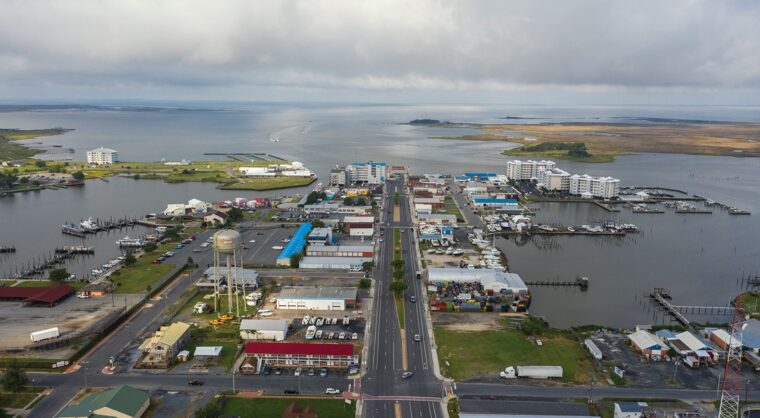
Earlier this month, the Federal Emergency Management Agency (FEMA) announced $1 billion for 656 new climate resiliency projects. The capital was awarded to support projects that address infrastructure risks and prepare for future natural disasters, including flooding, drought, earthquakes and extreme heat.
Approximately $395 million will be invested in 28 flood-control projects designed to eliminate or reduce damage. More than $236 million will be awarded to 30 utility infrastructure-protection projects that make improvements, such as upgrading power poles, burying electrical lines, adding backup power generators to essential facilities and elevating pump stations. The upcoming contracting opportunities will not launch for months, but most will move quickly due to urgent critical needs.
The city of Crisfield, Maryland, received $36 million for a flood mitigation project. The work will create a circle of flood protection infrastructure around the city by raising the current flood protection barriers by more than 3 feet. When completed, the city will be protected from flooding if water flows are 5 feet above sea level.
The overall initiative is to protect both sides of the city, but this first funding allocation is designated only for work on the city’s south side. Design work will include both areas, but there could be a lag between work until the second tranche of funding is awarded. Elements of the project’s first phase include tide gates, elevated roadways and improved drainage systems. The proposed elements of the second phase will consist of similar improvements and a new pump station. Construction will begin in 2026.
City officials at Del Mar, California, will move forward with several phases of a project to bury power lines underground throughout the city. The total cost of this project could be as much as $100 million. The benefits include increased reliability of utility services and reduced fire hazards from sparking power lines. This month, a $10 million contract was awarded for Phase 1A of the project, and the next phase of this effort has a projected cost estimate of $16.6 million. Pre-bidding for this phase will begin in August, with the goal of awarding a contract by November 2024. The plan is to convert 11,200 feet of overhead lines to about 14,300 feet of underground line. Over 70 poles will be relocated or removed. The work will involve 152 properties and 114 residences.
The next phase, named 1B or Stratford Court North, is currently in the design phase and will go to bid in 2025. The most-recent estimates suggested a cost of $3.3 million for this phase, but that will likely be revised upward. The Stratford Court North phase will involve 40 poles and about 4,300 feet of overhead line on 175 properties. Several more phases are planned for this project, including Phase 2 in Beach Colony and Phase 3 in South Hill. The city is currently forming the districts for these phases and will begin design work for them next.
The city of Savannah, Georgia, was awarded $30 million for a flood mitigation project, and city leaders have announced another $12 million will be made available for the $42 million project. Both FEMA and the Georgia Emergency Management Agency are supporting the city in this effort. The project will address flooding and drainage issues that have impacted two older neighborhoods, namely Cloverdale and Carver Village. The mitigation plan will include new coverts, storm drains and upgraded infrastructure construction to direct runoff into the Springfield Canal rather than into neighborhoods, retail and commercial spaces. City planners expect the project to continue over the next five years. Approximately $3 million has been allocated for surveying and engineering. Once that work is completed, more details will be available.
The Oglala Sioux Tribe, located in the Pine Ridge Indian Reservation in South Dakota, was awarded $60 million for a transportation resiliency project to improve 29 miles of roadway along Route 33. The objective will be to stabilize the highway by improving drainage and using resilient pavement to protect the roadway from damage caused by flooding, snow and ice accumulation, erosion and continually increasing evacuation traffic. Other project components will include widening ditches, increasing the size of culverts, adding larger culverts, raising sections of the road and widening highway shoulders for emergencies and evacuations. Construction will begin in 2026.
The city of Tulsa, Oklahoma, was awarded $19 million to redesign and upgrade an intersection that is prone to flooding. Another $6.5 million will come from the city to fully fund the street crossing project. Flooding has plagued cars and emergency vehicles for years, and often it is almost impossible for responders to maneuver through the intersection during storms safely. Floodwater comes from the nearby Fulton Creek Watershed, and because of the lack of protective infrastructure, parts of the city are very vulnerable to flooding.
The project will increase sewer system capacity with larger culverts and improve the rainwater channel and stormwater detention. Another project objective will be to prepare the city for major flooding, which is less common but extremely destructive and dangerous when it occurs. Preparation work, which includes an engineering design and a cost-benefit analysis, has already started. The effort may be ready for construction in late 2025.
Interested parties should begin immediately to check on projects of interest. Some will involve community input, and others will not, but stakeholders are always interested in meeting potential bidders before solicitation documents are drafted.
Photo courtesy of the Nature Conservancy
The post Funding released to support hundreds of new climate resilience projects appeared first on Government Market News.
